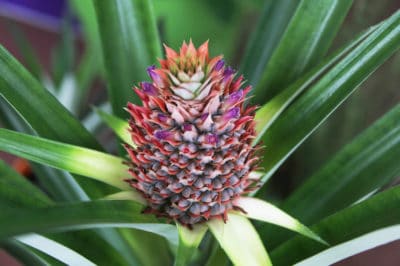Planting
Most people grow pineapples by propagating the green tops off of store-bought or homegrown fruit. These green palm-tree looking tops will root and become new plants.
The soil needs to be well-draining. Waterlogged pineapples will not be happy plants. Outdoor garden beds should be worked thoroughly and amended with compost, kelp, fish meal, or anything else that you have on hand to enrich the soil.
Fill containers with a high-quality potting soil. Purchase an organic potting soil or make your own with the following recipe.
- One Part Peat
- One Part Perlite
- One Part Screened Compost
Mix these together to form a great container soil that will drain excess water and feed plants over time.
Watering
Pineapples need very little water to survive. Too little water can cause fruits to be small, and standing water will invite disease. If the soil drains well, it’s difficult to give too much water. However, there’s no reason to waste water when it isn’t necessary.
Look into the crown of the plant. Where the leaves come together, there are little pockets. If these pockets contain water, then you don’t need to water the plant. If they are dry, then water it. Water over the leaves so the pockets fill. Pineapples take in most of their nutrients through the leaves, and these standing water pockets will sustain them.
Feeding
Do not feed your pineapple plant for the first two to three months. Let it become established first.
Outdoor plants can be mulched with one to three inches of good compost every couple of months. Add a layer of organic material on top of the compost to trap in moisture and aid in decomposition.
Container pineapples can receive a liquid fertilizer every one to three months. If you plant shows no signs of deficiency, plan on feeding every three months. Different types of organic fertilizer provide different nutrients. Synthetic soluble fertilizers often contain high nitrogen levels which can be detrimental to proper pineapple growth. Consider one of the following:
- Compost Tea
- Liquid Fish Emulsion
- Liquid Seaweed Extract
With any liquid fertilizer, dilute it to a half-strength consistency and pour it over the foliage of the pineapple plant. Do not leave strong fertilizers in the leaf pockets, this may burn the plant.
Staking
Staking may be necessary if the plant becomes top heavy or lopsided.
